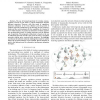PIMRC
2008
IEEE
14 years 6 months ago
2008
IEEE
—One of the major challenges in designing cellular Cognitive Radio (CR) networks is the avoidance of Secondary User (SU) interference to so called Primary Users (PUs) operating i...
PIMRC
2008
IEEE
14 years 6 months ago
2008
IEEE
PIMRC
2008
IEEE
14 years 6 months ago
2008
IEEE
—The development of mobile ad hoc systems have considerably emphasized the need for a better understanding of the factors that influence the systems’ performance, i.e., mobili...
PIMRC
2008
IEEE
14 years 6 months ago
2008
IEEE
: We propose an improved beamforming matrix compression by Givens Rotation with the use of variable feedback rate. The variable feedback rate means that the number of bits used to ...
PIMRC
2008
IEEE
14 years 6 months ago
2008
IEEE
Sensor network applications are generally characterized by long idle durations and intermittent communication patterns. The traffic loads are typically so low that overall idle d...
PIMRC
2008
IEEE
14 years 6 months ago
2008
IEEE
Abstract—The use of licensed spectrum for wireless communication is driven by the need to control interference between different operators. However, with this mode of regulation,...
PIMRC
2008
IEEE
14 years 6 months ago
2008
IEEE
—The call-level performance modelling and evaluation of 3G cellular networks is important for the proper network dimensioning and efficient use of the network resources, such as ...
PIMRC
2008
IEEE
14 years 6 months ago
2008
IEEE
Abstract— A continuously increasing demand for higher spectral efficiencies in mobile communications will require next generation cellular systems to employ a very dense reuse o...
PIMRC
2008
IEEE
14 years 6 months ago
2008
IEEE
—In this paper we present an analytical approach to evaluate the M-QAM bit error rate and carrier frequency dependent throughput of OFDM systems subject to various receiver impai...
PIMRC
2008
IEEE
14 years 6 months ago
2008
IEEE
We analyze the performance ofvoice services over 3GPP WCDMA Networks for Release 99 and Release 7 deployments. We show, by using simulations, that the system capacity of Release 7 ...

